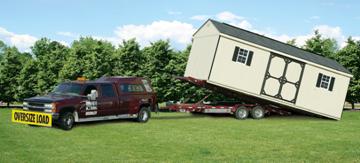Preparing For Your New Shed in 4 Easy Steps
What you will need to prepare for your shed delivery.
1. Decide Where To Place Your Shed
- What is the primary purpose of your new structure?
- Is it important for it to be close to a back door or side door?
- Will you need daily/weekly/monthly access to it?
- Do it matter to you if the shed can be seen from the street?
Like many homeowners, where to place your shed is probably the first thing you considered when you began researching shed options. If you haven’t thought through placement yet, that’s ok! We spoke with expert space planner Will Hapeman who suggests these helpful questions to get you started.

“You probably know what will go into your new shed but give some thought to who will be using. If you plan to store the kid’s pool toys or bikes, you may want it closer to the house,” advises Hapeman.
If you are using your structure primarily for lawn care or gardening, you’ll want your shed to be nearby.
Place your shed in the direct path of daily sunlight. Remember to account for slight differences in the sun’s location between seasons.
Measure how far the closest water source is if you plan to use your shed as a greenhouse or need water close by for other reasons.
If you plan to use tools that require electricity or want lighting, make sure you’re close enough to a power supply if you don’t upgrade your shed with the electrical package.
Pro Tip: Make sure to select a flat area so the shed will be level. In most cases, you should be able to eyeball it. In a worst case scenario, you may have to do a bit of digging to remove any bumps or large rocks. And don’t forget to decide which way the shed will face. Which side do you want the door/doors to open?
2. Check local zoning rules and permitting regulations
Not all municipalities require a building permit for sheds, but it’s a good idea to check first rather than find out later that you need one.
The most common restrictions relate to size, placement, electrical wiring (if applicable in your case), purpose, type of foundation, and distance from other objects and property lines.
Visit your county or township website or call the township office to ask whether a building or zoning permit is required.
Homeowners’ Associations
Ask a board member about any restrictions or guidelines they may have. Check with us if the zoning office requires any paperwork — we may be able to supply the forms to you.
3. Preparing the Site For Your New Shed
Foundation. Hiring a professional is the easiest way to prepare a foundation for your new backyard building, if it’s in your budget. We work with several foundation experts who we trust and can recommend a few to you.
However, if you decide to tackle this yourself, the first thing to decide is which type of foundation to put down.
Crushed Stone. Use about 3 inches of crushed stone with at least a 12-inch stone perimeter that will extend beyond the shed on all sides.
Start by clearing grass and dirt from your site in an area a little bigger than your shed. Make sure to keep this new dug up earth as flat as you can. Spread stone to create a 3-inch thick base. Finally, flatten out the stone by stepping on a 4 x 4 or using a tamper.
Concrete Base. Concrete is the optimal base for your structure. The base must be level, square, and designed to suit the floor size of the selected building. When the appropriate company contact you to arrange a delivery date, ask them for a base plan, and make sure that you stick rigidly to this – failure to do so may mean that the building cannot be installed without alterations.
Rows of Paving Slabs. Simple and effective. The best solution if you think the building might need to be moved in the future.

4. Delivery
Your new structure will arrive completely built. It’s important that our delivery team can access the area you’ve selected to place your shed. Walk along the path you think the delivery driver would take. If you foresee any problems with the path, contact us and we can do a site-check for you. If necessary, we can build your shed on site for an additional charge
Shed Truck Delivery Checklist
Here are a few items to consider prior to delivery.
- Calculate your shed’s total clearance: Shed length + 4 feet = __________ feet of total clearance needed. Is there enough clearance to manuever from the street to your selected location?
- Obstacles: Are there trees, wells, or other buildings that will interfere?
- Terrain: Is the terrain suitable* for a delivery truck and shed?
*We are unable to deliver sheds in wet conditions. Swampy areas, septic systems, or any ares that is typically damp or wet.